Electric Charges And Fields NEET Questions
NEET Physics For Electric Charges And Field Multiple Choice Questions
Question 1. Two point charges A and B having charges + Q and – Q respectively, are placed at a certain distance apart and force acting between them in F. If 25% of charges of A is transferred to B, then the force between the charges becomes
- \(\frac{9 F}{16}\)
- \(\frac{16 F}{9}\)
- \(\frac{4 F}{3}\)
- F
Answer: 1. \(\frac{9 F}{16}\)
We can write from the given question,
Two point charges A and B having charges + Q and – Q respectively, are placed at a certain distance apart and force acting between them in F. If 25% of charges of A is transferred to B

F= \(k \frac{Q^2}{r^2}\)
If 25% of the charge of A transferred to B then,
⇒ \(q_{\mathrm{A}}=Q-\frac{Q}{4}=\frac{3 Q}{4}\)
and \(q_B=-Q+\frac{Q}{9}=\frac{-3 q}{4}\)
⇒ \(F_1=\frac{K q_{\mathrm{A}} q_{\mathrm{B}}}{r^2}\)
⇒ \(F_1=\frac{K\left(\frac{3 Q}{4}\right)^2}{r^2}=\frac{9}{16} \frac{K Q}{r^2}\)
∴ \(F_1=\frac{9 F}{16}\) .
NEET Physics Practice Questions
Question 2. Suppose the charge of a proton and an electron differ slightly. One of them is e and the other is (e + Δe). If the net electrostatic force and the gravitational force between two hydrogen atoms placed at a distance d (much greater than atomic size) apart are zero, then Ae is of the order [Given the mass of hydrogen if, mh = 1.67 x 10-27 kg]:
- 10-20C
- 10-23C
- 10-37C
- 10-47C
Answer: 3. 10-37C
Read and Learn More NEET Physics MCQs
Here gravitational attractive force between two H-atoms is \(F_G=\frac{G m^2}{d^2}\) → Equation 1
and electrostatic repulsive force between two H-atom is \(F_e=\frac{K q^2}{d^2}=\frac{K(\Delta e)^2}{d^2}\) → Equation 2
Thus we have, \(\frac{K(\Delta e)^2}{d^2}=\frac{G m^2}{d^2}\)
⇒ \(9 \times 10^9(\Delta e)^2=6.67 \times 10^{-11} \times 1.67 \times 10^{-27} \times 1.67 \times 10^{-27}\)
⇒ \((\Delta e)^2=\frac{6.67 \times 1.67 \times 1.07}{9} \times 10^{-74}\)
∴ \(\Delta e=1.437 \times 10^{-37} \mathrm{C}\)
Question 3. Two identical charged spheres suspended from a common point by two massless strings of lengths /, are initially at a distance d (d < 1) apart because of their mutual repulsion. The charges begin to leak from both spheres at a constant rate. As a result, the spheres approach each other with a velocity v. Then, v varies as a function of the distance x between the spheres, as:
- v \(\propto x^{-1 / 2}\)
- v \(\propto x^{-1}\)
- v \(\propto x^{-1}\)
- v \(\propto x^{1 / 2}\)
Answer: 2. v \(\propto x^{-1}\)
From the diagram,
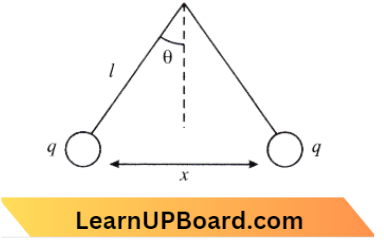
⇒ \(\tan \theta=\frac{F_e}{m g}=\theta\)
⇒ \(\frac{K q^2}{x^2 m g}=\frac{x}{2 l}\)
or \(x^3 \propto q^2\) → Equation 1
or \(x^{3 / 2} \propto q\) → Equation 2
differential eq. (1) w.r.t. to time,
⇒ \(3 x^2 \frac{d x}{d t} \propto 2 q \frac{d q}{d t}\)
but \(\frac{d q}{d t}\) is constant.
So \(x^2(v) \propto q \)replace q from eq. (2),
⇒ \(x^2(v) \propto x^{3/2}\)
∴ \(v \propto x^{+1 / 2}\)
Question 4. Two pith balls carrying equal charges are suspended from a common point by strings of equal length, the equilibrium separation between them is r. Now the strings are rigidly damped at half the height. The equilibrium separation between the balls now becomes.
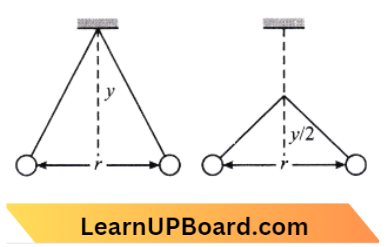
- \(\left(\frac{1}{\sqrt{2}}\right)^2\)
- \(\left(\frac{r}{\sqrt[3]{2}}\right)\)
- \(\left(\frac{2 r}{\sqrt{3}}\right)\)
- \(\left(\frac{2 r}{3}\right)\)
Answer: 2. \(\left(\frac{r}{\sqrt[3]{2}}\right)\)
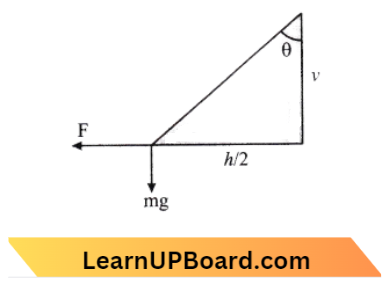
Given
Two pith balls carrying equal charges are suspended from a common point by strings of equal length, the equilibrium separation between them is r. Now the strings are rigidly damped at half the height.
Here, \(\tan \theta =\frac{F}{m g}\)
⇒ \(\frac{r}{y} =\frac{k q^2}{r^2 m g}\)
⇒ \(y \propto r^3\)
⇒ \(\left(\frac{r^1}{r}\right)^3=\frac{y / 2}{y}\)
∴ \(r^1=r\left(\frac{1}{2}\right)^{1 / 3}\)
NEET Physics Practice Questions
Question 5. A charge ‘q’ is placed at the centre of the line joining two equal charges ‘Q. The system of three charges will be in equilibrium if ‘q’ is equal to:
- -S/4
- g/4
- – e/2
- e/2
Answer: 1. -S/4
According to the question,
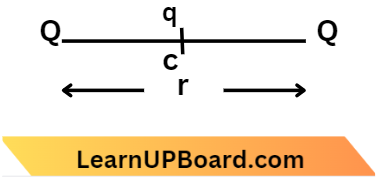
for equilibrium, the net force on charge p = 0
⇒ \(\frac{1}{4 \pi \epsilon_0} \frac{\mathrm{Q} q}{r^2}+\frac{1}{4 \pi \epsilon_0} \cdot\)
⇒ \(\frac{\mathrm{Q}^2}{\left(\frac{r}{2}\right)^2}\)=0
⇒ \(\frac{1}{4 \pi \epsilon_0} \frac{\mathrm{Q}^2}{r^2} =-\frac{1}{4 \pi \epsilon_0} \frac{4 \mathrm{Q} q}{r^2}\)
Q=-4 q
q = \(-\frac{Q}{4}\)
Question 6. Two positive ions, each carrying a charge q, are separated by a distance d. If F is the force of repulsion between the ions, the number of electrons missing from each ion will be (e being the charge on an electron):
- \(\frac{4 \pi \varepsilon_0 F d^2}{e^2}\)
- \(\sqrt{\frac{4 \pi \varepsilon_0 F e^2}{d^2}}\)
- \(\sqrt{\frac{4 \pi \varepsilon_0 F d^2}{e^2}}\)
- \(\frac{4 \pi \varepsilon_0 F d^2}{q^2}\)
Answer: 3. \(\sqrt{\frac{4 \pi \varepsilon_0 F d^2}{e^2}}\)
Given
Two positive ions, each carrying a charge q, are separated by a distance d. If F is the force of repulsion between the ions,
The force of repulsion between them is,
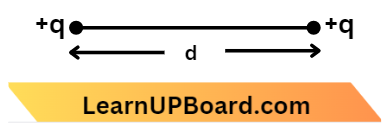
F=\(k \frac{q q}{d^2}=\frac{1}{4 \pi \varepsilon_0} \frac{q q}{d^2}\) → Equation 1
Here, q = ne
F= \(\frac{1}{4 \pi \varepsilon_0} \frac{(n e)(n e)}{d^2}\)
n= \(\sqrt{\frac{4 \pi \varepsilon_0 F d^2}{e^2}}\)
Electric Charges And Fields NEET Questions
Question 7. The unit of permittivity of free space ε0 is:
- coulomb/newton-metre
- newton-metre2/coulomb2
- coulomb2/newton-metre2
- coulomb2/(newton-metre)2
Answer: 3. coulomb2/newton-metre2
We know that, F =\(\frac{1}{4 \pi \varepsilon_0} \frac{q^2}{r^2}\)
∴ \(\varepsilon_0 =\frac{1}{4 \pi} \frac{a^2}{\mathrm{Fr} r^2}=\frac{\mathrm{C}^2}{\mathrm{~N}-\mathrm{m}^2}\)
Question 8. An electron is moving around the nucleus of a hydrogen atom in a circular orbit of radius r. The coulomb force \(\vec{F}\) between the two is \(\left(\text { where } K=\frac{1}{4 \pi \varepsilon_0}\right)\):
- \(K \frac{e^2}{r^2} \hat{r}\)
- -K \(\frac{e^2}{r^3} \hat{r}\)
- -K \(\frac{e^2}{r^2} \hat{r}\)
- K \(\frac{e^2}{r^3} \hat{r}\)
Answer: 4. K \(\frac{e^2}{r^3} \hat{r}\)
The charge on hydrogen nuclear \(q_1=+v e \)
Coulomb’s force, F =\( K \frac{q_1 q_2}{r^2}\)
= K \(\frac{(+e)(-e)}{r^2} \hat{r}=-\frac{k e^2}{r^2} \hat{r}\)
Question 9. When air is replaced by a dielectric medium of constant k, the maximum force of attraction between two charges, separated by a distance
- decreases K times
- increases AT times
- remains uncharged
- becomes – times
Answer: 1. decreases K times
According to Coulomb’s law, the force between two charges is directly proportional to the product of charges and inversely proportional to the square of the distance between them.
F=\(\frac{1}{4 \pi \varepsilon_0} \frac{q_1 q_2}{r^2}\) → Equation 1
Where, \(\frac{1}{4 \pi \varepsilon_0}\) = proportionality constant
If a dielectric medium of constant K is placed between them, then, a new force between the charges will be,
⇒ \(F_1=\frac{1}{4 \pi \varepsilon_0 K} \frac{q_1 q_2}{r^2}\) → Equation 2
Dividing Eq. (2) by (1), we get,
⇒ \(\frac{F_1}{F}=\frac{1}{k}\)
⇒ \(F^{\prime}=\frac{F}{k}\)
∴ Thus, the new force decreases K times.
Electric Charges And Fields NEET Questions
Question 10. An electron falls from rest through a vertical distance h in a uniform and vertically upward-directed electric field E. The direction of the electric field is now reversed, keeping its magnitude the same. A proton is allowed to fall from rest in it through the same vertical distance h. The time of fall of the electron, in comparison to the time of fall of the proton is:
- 10 times greater
- 5 times greater
- smaller
- equal
Answer: 3. smaller
Given
An electron falls from rest through a vertical distance h in a uniform and vertically upward-directed electric field E. The direction of the electric field is now reversed, keeping its magnitude the same. A proton is allowed to fall from rest in it through the same vertical distance h.
Consider, the force on a charged particle in an electric field is: F = qE
And from Newton’s 2 \( { }^{\text {nd }}\) law of motion,
F = ma
From the above two equations,
qE = ma
a =\(\frac{q E}{m}\) → Equation 1
Now consider that particle falls from rest means u=0 and s=h
S= \(u t+a t^2 \)
h= \(\frac{1}{2} a t^2\)
h= \(\frac{1}{2}\left(\frac{q E}{m}\right)^{t^2}\)
h= \(\frac{1}{2} \frac{q E}{m} t^2\)
t= \(\sqrt{\frac{2 h m}{q E}}\)
NEET Physics MCQs
Question 11. The electric field in a certain region is acting radially outward and is given by E = Ar. A charge contained in a sphere of radius ‘a’ centred at the origin of the field’ will be given by:
- \(4 \pi \varepsilon_0 A a^2\)
- A \(\varepsilon_0 a^2\)
- 4 \(\pi \varepsilon_0 A a^3\)
- \(\varepsilon_0 A a^3\)
Answer: 3. 4 \(\pi \varepsilon_0 A a^3\)
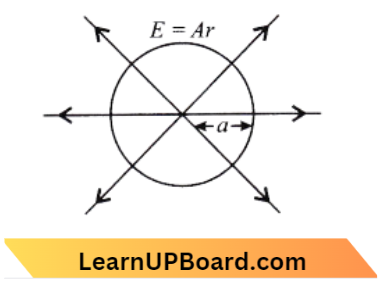
From eq.(1)\( t \propto \sqrt{m}\) a q is the same for electron and proton.
Since an electron has a smaller mass it will take less time.
Question 12. The electric field at a distance \(\frac{3 R}{2}\) from the centre of a charged conducting spherical shell of radius R is E. The electric field at a distance \(\frac{R}{2}\) from the centre of the sphere is:
- zero
- E
- \(\frac{E}{2}\)
- \(\frac{E}{3}\)
Answer: 1. zero
We know that the electric field inside the conductor is zero. So, the electric field at a distance \(\frac{R}{2}\) from the centre of the sphere will also be zero.
Question 13. A particle of mass m and charge q is placed at rest in a uniform electric field E and then released. The kinetic energy attained by the particle after moving a distance y is:
- \(q E y^2\)
- \(q E^2 y\)
- \(q E y\)
- \(q^2 E y\)
Answer: 3. \(q E y\)
We have, electric force on a charged particle, F = qE
Mechanical on a charged particle in a uniform electric field is, F = ma = Eq
a = \(\frac{q E}{m}\)
From the equation of motion, we get,
⇒ \(v^2 =u^2+2 a y \)
a =\(\frac{q E}{m}\)
= \(\frac{2 q E \mathrm{y}}{m}\)
⇒ \(\ldots[\mathrm{u}=0]\)
Now, kinetic energy of the particle, k =\(\frac{1}{2} m v^2 \)
= \(\frac{m}{2} \times \frac{2 q E \mathrm{y}}{m}=q E y\)
NEET Physics MCQs
Question 14. A square surface of side Z metre in the plane of the paper is placed in a uniform electric field E (volt/m) acting along the same place at an angle θ with the horizontal side of the square as shown in the figure. The electric flux linked to the surface in a unit of V-m is
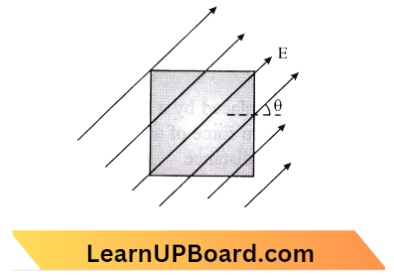
- \(E L^2\)
- \(E L^2 \cos \theta\)
- \(E L^2 \sin \theta\)
- 0
Answer: 4. 0
Given
A square surface of side Z metre in the plane of the paper is placed in a uniform electric field E (volt/m) acting along the same place at an angle θ with the horizontal side of the square as shown in the figure.
We know that, flux, \(\phi =\vec{E} \cdot \vec{A}\)
= E A \(\cos \theta=\vec{E} \cdot \vec{A}\)
And \(\vec{E} \cdot \vec{A}\)=0 then lines are parallel to the surface.
Question 15. A square surface of side L metres is in the plane of the paper. A uniform electric field \(\vec{E}\)(volt/m), also in the plane of the paper, is limited only to the lower half of the square surface (see figure). The electric flux in SI units associated with the surface is:
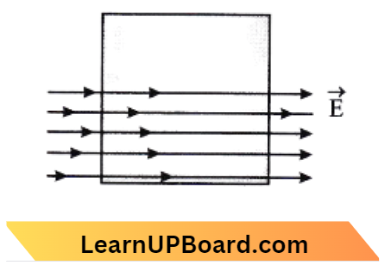
- \(E L^2\)
- \(E L^2 / 2 \varepsilon_{\mathrm{o}}\)
- \(E L^{2 / 2}\)
- zero
Answer: 4. zero
Given
A square surface of side L metres is in the plane of the paper. A uniform electric field \(\vec{E}\)(volt/m), also in the plane of the paper, is limited only to the lower half of the square surface
Electric flux \(\phi_E =\int \vec{E} \cdot \overrightarrow{d s}=\int E d s \cos \theta\)
= \(\int E d s \cos 90^{\circ}\)=0
Electric Charges And Fields MCQs
Question 16. Two point charges -q and +q are placed at a distance of L, as shown in the figure. The magnitude of electric field intensity at a distance R (R > >L) varies as:
- \(\frac{1}{\mathrm{R}^2}\)
- \(\frac{1}{\mathrm{R}^3}\)
- \(\frac{1}{\mathrm{R}^4}\)
- \(\frac{1}{\mathrm{R}^6}\)
Answer: 2. \(\frac{1}{\mathrm{R}^3}\)
The electric field due to a dipole at any arbitrary point (R, Q) is
⇒ \(\mathrm{E}=\frac{p}{4 \pi \varepsilon_0 R^3} \sqrt{3 \cos ^2 \theta+1}\)
⇒ \(\mathrm{E} \propto \frac{1}{\mathrm{R}^3}\) .
∴ Here, \(\mathrm{E} \propto \frac{1}{\mathrm{R}^3}\).
Question 17. Polar molecules are the molecules:
- having zero dipole moment.
- acquire a dipole moment only in the presence of an electric field due to the displacement of charges.
- acquire a dipole moment only when the magnetic field is absent.
- having a permanent electric dipole moment.
Answer: 4. having a permanent electric dipole moment.
Polar molecules are molecules having a permanent electric dipole moment.
Question 18. The electric field at a point on the equatorial plane at a distance r from the centre of a dipole having dipole moment P is given by (r > > separation of two charges forming the dipole \(\varepsilon_0\) = permittivity of free space):
- \(\frac{-P}{4 \pi \varepsilon_0 r^3}\)
- \(\frac{2 P}{4 \pi \varepsilon_0 r^3}\)
- \(-\frac{P}{4 \pi \varepsilon_0 r^2}\)
- \(\frac{P}{4 \pi \varepsilon_0 r^2}\)
Answer: 1. \(\frac{-P}{4 \pi \varepsilon_0 r^3}\)
Electric field due to an electric dipole at an equatorial plane at a distance r from the centre of the dipole is given by:
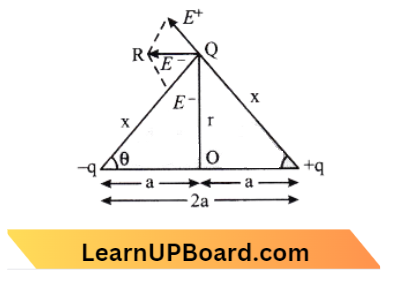
⇒ \(E_e=\frac{q(2 a)}{4 \pi \varepsilon_0\left(r^2+a^2\right)^{3 / 2}}\)
Directed from Q to R,
⇒ \(E_e=-\frac{P}{4 \pi \varepsilon_0\left(r^2+a^2\right)^{\frac{3}{2}}}\)
For a very short dipole (a < < r),
∴ \(E_e=-\frac{P}{4 \pi \varepsilon_0 r^3}\)
Electric Charges And Fields MCQs
Question 19. Three point charges +q, -2q and +q are placed at points (x = 0, y = a, z = 0), (x = 0, y = 0, z = 0) and (x = a, y = 0, z = 0) respectively. The magnitude and direction of the electric dipole moment vector of this charge assembly are:
- \(\sqrt{2}\) q a along the line joining points (x=0, y=0, z=0) and (x=a, y=a, z=0)
- q a along the line joining points (x=0, y=0, z=0) and (x=a, y=a, z=0)
- \(\sqrt{2}\) q a along +x direction
- \(\sqrt{2}\) q a along +y direction
Answer: 1. \(\sqrt{2}\) q a along the line joining points (x=0, y=0, z=0) and (x=a, y=a, z=0)
This consists of two dipoles, – q and +4 with dipole moment along with the +y direction and q and +q along the X-direction.
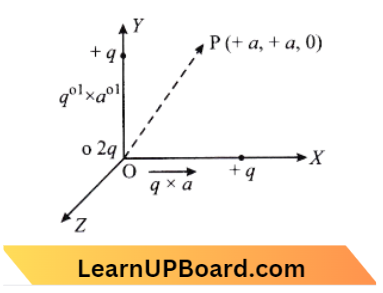
The resultant moment ,=\(\sqrt{q^2 a^2+q^2 a^2}\) = \(\sqrt{2} q a\)
Along the direction 45″ that is along OP where P is (+a, a,0)
Question 20. The formation of the dipole is due to two equal and dissimilar point charges placed at a:
- short distance
- long distance
- above each other
- None of these
Answer: 1. short distance
A pair of equal and opposite point charges separated by a small distance form an electric dipole. Electric dipoles are atoms or molecules of ammonia, water alcohol, carbon dioxide, HCl, and other compounds in which the centres of positive and negative charge distributions are separated by a small distance
NEET Electric Charges Questions
Question 21. The intensity of an electric field (E) depends on distance r due to a dipole, is related to:
- E\( \propto \frac{1}{r}\)
- E \(\propto \frac{1}{r^2}\)
- E \(\propto \frac{1}{r^3}\)
- E \(\propto \frac{1}{r^4}\)
Answer: 3. E \(\propto \frac{1}{r^3}\)
On the axial line of an electric dipole, the field intensity is given by E=\(\frac{1}{4 \pi \varepsilon_0} \cdot \frac{2 p}{r^3}\) → Equation 1
Electric field at equatorial position, E=\(\frac{1}{4 \pi \varepsilon_0} \cdot \frac{p}{r^3}\) → Equation 2
where. p is electric dipole moment,
From (1) and (2), we get E \(\propto \frac{1}{\mathrm{r}^3}\)
Question 22. An electric dipole is placed at an angle of 30° with an electric field intensity of 2 x 105 N/C. It experiences a torque equal to 4 Nm. The charge on the dipole. If the dipole length is 2 cm is:
- 8 mC
- 2 mC
- 5 mC
- 7μC
Answer: 2. 2 mC
We know that the Torque in an electric dipole is
⇒ \(\vec{\tau}=\vec{P} \times \vec{E}\)
⇒ \(|\tau| =P E \sin \theta\)
We can write, \(\tau=q 2 l E \sin \theta=q \times 2 l \times E \sin \theta\)
putting the given values we have, 4 =q \(\times 2 \times 2 \times 10^{-4} \times 2 \times 10^5 \times \sin 30^{\circ}\)
q =2 \(\times 10^{-3} \mathrm{C}=2 \mathrm{mC}\)
NEET Electric Charges Questions
Question 23. A spherical conductor of radius 10 cm has a charge of 3.2 x 10-7 distributed uniformly. What is the magnitude of the electric field at a point 15 cm from the centre of the Sphere \(\left(\frac{1}{4 \pi \varepsilon_0}=9 \times 10^9 \mathrm{Nm}^2 / \mathrm{C}^2\right)\)
- \(1.28 \times 10^5 \mathrm{~N} / \mathrm{C}\)
- 1.28 \(\times 10^6 \mathrm{~N} / \mathrm{C}\)
- 1.28 \(\times 10^7 \mathrm{~N} / \mathrm{C}\)
- 1.28 \(\times 10^4 \mathrm{~N} / \mathrm{C}\)
Answer: 1. \(1.28 \times 10^5 \mathrm{~N} / \mathrm{C}\)
Given: r=10 \(\mathrm{~cm}=10 \times 10^{-2} \mathrm{~m}\)
Charge, q=3.2 \(\times 10^{-7} \mathrm{C}\)
The electric field at a point (x=15 cm ) from the centre of the sphere is:
⇒ \(\mathrm{E} =\frac{1}{4 \pi \varepsilon_0} \frac{q}{x^2}\)
= \(9 \times 10^9 \times \frac{3.2 \times 10^{-7}}{225 \times 10^{-4}}\)
= \(1.28 \times 10^5 \mathrm{~N} / \mathrm{C}\) .
Question 24. A thin conducting ring of radius R is given a charge + Q. The electric field at the centre O of the ring due to the charge on the part AKB of the ring is E. The electric field at the centre due to the charge on the part ACDB of the ring is:
- 3 E along KO
- 3 along OK
- E along KO
- 3 E along OK
Answer: 2. 3 along OK
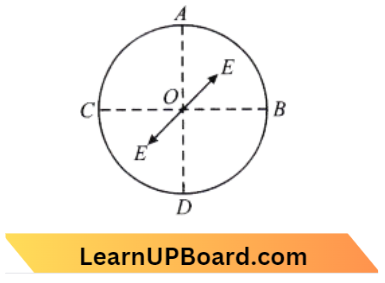
The electric field due to the given charged ring is zero at centre O. So electric field due to AKB is equal and opposite to the electric field due to ACDB, from the principle of superposition. Since \(\overrightarrow{\mathrm{E}}\) is field strength, of O along \(\overrightarrow{K O}\) . So electric field strength due to ACDB along \(\overrightarrow{O K}\) and it is equal to E.
Question 25. The electric field strength in air at NTP is 3 x 108 V/m. The maximum charge that can be given to a spherical conductor of radius 3 m is:
- 3 x 104 C
- 3 x 10-3 C
- 3 x 10-2 C
- 3 x 10-1 C
Answer: 2. 3 x 10-3 C
Given, \(E_{\max }=3 \times 10^6 \mathrm{~V} / \mathrm{m}\) and R=3 \(\mathrm{~m}\) We have,
E =\(\frac{1}{4 \pi \varepsilon_0} \times \frac{Q}{R^2}\)
⇒ \(Q_{\max } =4 \pi \varepsilon_0 R^2 E_{\max }\)
=\(\frac{3 \times 3 \times 3 \times 10^6}{9 \times 10^9}\)
=3 \(\times 10^{-3} \mathrm{C}\)
Class 12 Physics MCQs For NEET
Question 26. Two spherical conductors A and B of radii 1 mm and 2 mm are separated by a distance of 5 cm and are uniformly charged. If the spheres are connected by a conducting wire then in equilibrium condition, the ratio of the magnitude of the electric fields at the surfaces of spheres A and B is:
- 4:1
- 1:2
- 2:1
- 1:4
Answer: 1. 4:1
When a conducting wire connects two conducting spheres, charge flows from one sphere (with a higher potential) to the other (with a lower potential) until both spheres have the same potential.
E=\(\frac{1}{4 \pi \varepsilon_0} \times \frac{q}{r^2}\)
So, for different cases, \(\frac{E_1}{E_2}=\left(\frac{r_2}{r_1}\right)^2\)=4: 1
Question 27. A sphere encloses an electric dipole with charge \(\pm 3 \times 10^{-6} \mathrm{C}\). What is the total electric flux across the sphere?
- \(-3 \times 10^{-6} \mathrm{~N}-\mathrm{m}^2 / \mathrm{C}\)
- zero
- \(3 \times 10^6 \mathrm{~N}-\mathrm{m}^2 / \mathrm{C}\)
- \(6 \times 10^{-6} \mathrm{~N}-\mathrm{m}^2 / \mathrm{C}\)
Answer: 2. zero
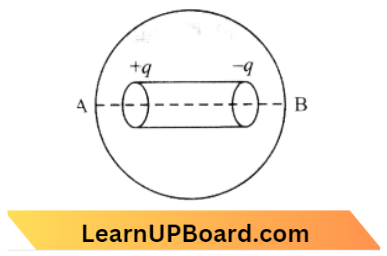
From the figure it is clear that the sphere is enclosed a change is q= \(\pm 3 \times 10^{-6} \mathrm{C}\) which means it is a dipole.
We know that,Flux, \(\phi=\frac{(\text { Charge })_{\text {inside }}}{\epsilon_0}=\frac{q_{\text {in }}}{\epsilon_0}\)
Here total charge inside the sphere is zero.
⇒ \(\phi=\frac{0}{\epsilon_0}\)=0
The charge enclosed is zero.
The total electric flux is zero.
Question 28. A charge Q is enclosed by a Gaussian spherical surface of radius R. If the radius is doubled, then the outward electric flux will:
- be reduced to half
- remain the same
- be doubled
- increases four times
Answer: 2. remain the same
⇒ \(\phi_{\text {net }}=\frac{\Sigma q}{\varepsilon_0}\)
Net flux does not depend on the size of the Gaussian surface.
So, Flux remain unchanged
Class 12 Physics MCQs For NEET
Question 29. A hollow cylinder has a charge q coulomb within it. If \(\phi\) is the electric flux in units of voltmeter associated with the curved surface B, the flux linked with the plane surface A in units of voltmeter will be:
- \(\frac{q}{2 \varepsilon_0}\)
- \(\frac{\phi}{3}\)
- \(\frac{q}{\varepsilon_0}-\phi\)
- \(\frac{1}{2}\left(\frac{q}{\varepsilon_0}-\phi\right)\)
Answer: 4. \(\frac{1}{2}\left(\frac{q}{\varepsilon_0}-\phi\right)\)
Let \(\phi_A, \phi_B\) and \(\phi_C\) be the electric fuse linked with A, B and C.
According to Gauss theorem, \(\phi_{\mathrm{A}}+\phi_{\mathrm{B}}+\phi_{\mathrm{C}}=\frac{q}{\varepsilon_0}\)
since, \(\phi_{\mathrm{A}}=\phi_{\mathrm{C}}\)
2 \(\phi_{\mathrm{A}}+\phi_{\mathrm{B}}=\frac{q}{\varepsilon_0}\)
or \(2 \phi_{\mathrm{A}}=\frac{q}{\varepsilon_0}-\phi_{\mathrm{B}}\)
or \(2 \phi_{\mathrm{A}}=\frac{q}{\varepsilon_0}-\phi \quad\left\{\text { since } \phi_{\mathrm{B}}=\phi\right\}\)
Question 30. A charge q is located at the centre of a cube. The electric flux through any face is:
- \(\frac{2 \pi q}{6\left(4 \pi \varepsilon_0\right)}\)
- \(\frac{4 \pi q}{6\left(4 \pi \varepsilon_0\right)}\)
- \(\frac{\pi q}{6\left(4 \pi \varepsilon_0\right)}\)
- \(\frac{-q}{6\left(4 \pi \varepsilon_0\right)}\)
Answer: 2. \(\frac{4 \pi q}{6\left(4 \pi \varepsilon_0\right)}\)
The electric flux through any face,
⇒ \(\phi_{\text {face }}=\frac{q}{\varepsilon_0}\)
= \(\frac{4 \pi q}{6\left(4 \pi \varepsilon_0\right)}\)
Physics MCQs For NEET With Answers
Question 31. A Charge q is placed at the corner of a cube of side a. The electric flux through the cube is:
- \(\frac{q}{\varepsilon_0}\)
- \(\frac{q}{3 \varepsilon_0}\)
- \(\frac{q}{6 \varepsilon_0}\)
- \(\frac{q}{8 \varepsilon_0}\)
Answer: 4. \(\frac{q}{8 \varepsilon_0}\)
According to Gauss law, the electric flux through a closed surface is equal to \(\frac{1}{\varepsilon_0}\) times the net charge enclosed by the surface.
since, q is the charge enclosed by the surface, then electric flux,q= \(\phi=\frac{1}{\varepsilon_0}\)
If charge q is placed in one of the cube’s corners, it will be divided into eight similar cubes.
Therefore, electric flux through the cube \(\phi^{\prime}=\frac{1}{8}\left(\frac{q}{\varepsilon_0}\right)\)
Question 32. A point charge + q is placed at the mid-point of a cube of side L. The electric flux emerging from the cube is:
- \(\frac{q}{\varepsilon_0}\)
- \(\frac{6 q L^2}{\varepsilon_0}\)
- \(\frac{q}{6 L^2 \varepsilon_0}\)
- zero
Answer: 1. \(\frac{q}{\varepsilon_0}\)
According to Gauss’s theorem, the total electric flux over a closed surface is \(\frac{1}{\varepsilon_0}\) times the total charges contained inside the surface.
Total electric flux =\(\frac{\text { Total charge inside cube }}{\varepsilon_0}\)
∴ \(\phi =\frac{\mathrm{q}}{\varepsilon_0}\)
Question 33. Two parallel infinite line charges with linear charge densities + \(\lambda\) C/m and – \(\lambda\), C/m is placed at a distance of 2R in free space. What is the electric field mid-way between the two line charges?
- \(\frac{2 \lambda}{2 \varepsilon_0 R} \mathrm{~N} / \mathrm{C}\)
- \(\frac{\lambda}{\pi \varepsilon_0 R} \mathrm{~N} / \mathrm{C}\)
- \(\frac{\lambda}{2 \pi \varepsilon_0 R} \mathrm{~N} / \mathrm{C}\)
- Zero
Answer: 2. \(\frac{\lambda}{\pi \varepsilon_0 R} \mathrm{~N} / \mathrm{C}\)

Electric field due to line charge (1), \(\vec{E}_1=\frac{\lambda}{2 \pi \varepsilon_0 R} \hat{i}\)
Electric field due to line charge (2),
⇒ \(\vec{E}_2 =\frac{\lambda}{2 \pi \varepsilon_0 R} \hat{i} \mathrm{~N} / \mathrm{C}\)
⇒ \(E_{\text {net }} =\vec{E}_1+\vec{E}_2\)
= \(\frac{\lambda}{2 \pi \varepsilon_0 \mathrm{R}} i+\frac{\lambda}{2 \pi \varepsilon_0 \mathrm{R}} \hat{i}\)
= \(\frac{\lambda}{\pi \varepsilon_0 \mathrm{R}} \hat{i} \mathrm{~N} / \mathrm{C}\)
Physics MCQs For NEET With Answers
Question 34. A hollow metal sphere of radius R is uniformly charged. The electric field due to the sphere at a distance r from the centre:
- zero as increases for r < Ri decreases as r increases for r > R
- zero as r increases for r < rRi increases as r increases for r > R
- decreases as r increases for r < R and for r > R
- increases as r increases for r < R and for r > R
Answer: 1. Zero as increases for r < Ri decreases as r increases for r > R
Charge Q will be distributed over the surface of a hollow metal sphere.
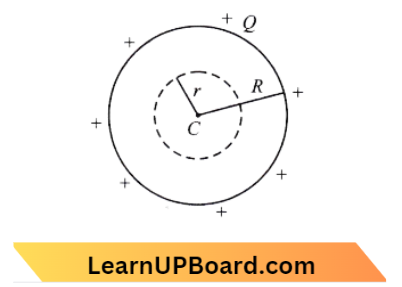
(1) For \(\mathrm{r}<\mathrm{R}(inside)\)
By gauss law \(\oint \overrightarrow{E_{1 \mathrm{n}}} \cdot \overrightarrow{d \mathrm{~s}}=\frac{q_{e n}}{\varepsilon_0}\)
∴ \(E_{\text {in }}=0 (q_{\text {en }}=0)\)
(2) For r>R (outside)
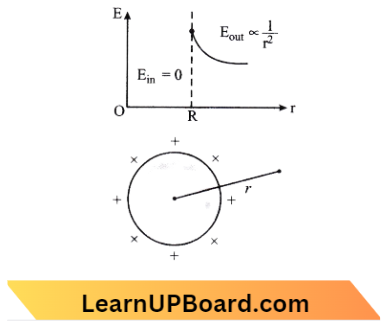
⇒ \(\oint \vec{E}_0 \cdot \overrightarrow{d s}=\frac{q_{e n}}{\varepsilon_0}\)
Here \(q_{\text {en }}\)=0
⇒ \(\left(q_{e n}=\mathrm{Q}\right)\)
For \(r>R,\vec{E}_0=\frac{1}{4 \pi \varepsilon_0} \frac{Q}{\left|\vec{R}^2\right|} \hat{r}\)
⇒ \(E_0 \propto \frac{1}{r^2}\)
∴ \(\vec{E}_0\) decreases
